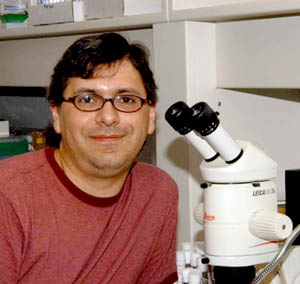Pediatric Sarcoma, Rhabdomyosarcoma, and Mechanisms of Origin
 NEWS:
NEWS:
Child Cancer Breakthrough: Rhabdo no more? -- www.the33tv.com
In the words of Rene Galindo:
A critical teaching pearl emphasized when learning about pediatric disease is that “children are not just little adults.” This statement highlights the fact that children suffer from unique diseases - diseases that for poorly understood reasons show a predilection for growing childhood tissue. These observations are especially true for cancer, since children often suffer from malignancies that are rarely if ever seen in adults. Of these cancers, the childhood sarcomas, which are tumors of the connective tissues (muscle, bone, fat) within the body, are notoriously deadly and very difficult to study experimentally.
The long term goal of my lab is to understand the genetic underpinnings of childhood sarcoma, and therein capitalize on new insights to devise new treatments. To accomplish this goal, we study the most common and deadly of all the childhood soft tissue sarcomas, rhabdomyosarcoma (RMS). RMS, a tumor that exhibits features of skeletal muscle, is often caused by mutation of two genes, PAX and FKHR, which have been known for years to drive RMS neoplasia. Nonetheless, how these genes promote RMS continues to remain unclear. Therefore, we have generated multiple model systems in our lab to study, profile, and dissect the genetics of these tumors - a battery of tools that are unique to our research team. With these models, we have identified genes that work in concert with PAX and FKHR to force neoplasia - genes that have been previously unknown as human disease genes, let alone RMS cancer genes. We are now actively characterizing the behavior of these genes, and how these genes convert otherwise normal muscle-type cells into cells that become cancer. We predict that learning how these genes “tick” will provide new avenues to target these genes, and thus directly poison RMS cells. Accomplishing these aims quite often seems more like a marathon than a sprint, but we are now publishing these findings, with more insights to come in the near future.
It is very important to note how instrumental developmental awards, such as the ‘A’ Award from ALSF, are to the success of labs such as mine. For example, this award has allowed me to recruit two new very talented researchers to my lab, and to fund a powerful bioinformatics study that we are applying to our experimental platforms. Without the time, dedication, and commitment of people involved with such splendid foundations such as ALSF, the ability to provide for and pursue these studies would be significantly more difficult. Instead, with the help of ALSF and others, we get the thrill everyday of trying to find new ways to save children from dreaded and deadly childhood diseases.
Project Update 2/2014
The major goal of my research program is to uncover new treatments for Rhabdomyosarcoma (RMS), the outcomes for which have not improved for three decades. We postulate that new genetic tools and approaches are needed to facilitate the dissection of RMS pathogenesis, promote gene discovery, and enable the development of novel therapies. Since receiving an ALSF ‘A’ award, we have been successful in generating new systems and approaches to achieve this goal. The ‘A’ award has been most instrumental to my career development. First, it has provided the support and protected time necessary for my career progression as junior faculty. Second, since my project has carried a certain aspect of risk, the award has provided my lab both resources and time needed to validate and demonstrate the power of our new model approaches. We are publishing these outcomes to the general biomedical community. We are optimistic that these new approaches will enhance our ability to improve treatments and cure kids with RMS in the near future.

